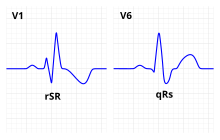| Intraventricular block | |
|---|---|
 | |
| ECG characteristics of an intraventricular block subtype - RBBB showing wide QRS complexes with a terminal R wave in lead V1 and a prolonged S wave in lead V6. | |
| Specialty | Cardiology |
| Diagnostic method | electrocardiogram |
An intraventricular block is a heart conduction disorder — heart block of the ventricles of the heart.[1] An example is a right bundle branch block, right fascicular block, bifascicular block, trifascicular block.[2][3]
Types
[edit]Types of intraventricular blocks are[4]
- Fascicular block
- Trifascicular block
- Bifascicular block (RBBB with fascicular block)
- Right bundle branch block (RBBB)
- Left bundle branch block (LBBB)
Intraventricular conduction delay
[edit]
Intraventricular conduction delays (IVCD) are conduction disorders seen in intraventricular propagation of supraventricular impulses resulting in changes in the QRS complex duration or morphology, or both. IVCD can be caused by abnormalities in the structures of bundle of His, Purkinje fibers or ventricular myocardium.[5][6] Nonspecific intraventricular conduction delay (NICD) is a delay with widened QRS complex but without a specific intraventricular block present.[7]
References
[edit]- ^ "Intraventricular Conduction - ECGpedia". en.ecgpedia.org. Retrieved 2021-10-17.
- ^ "Lesson VI - ECG Conduction Abnormalities". Retrieved 2009-01-07.
- ^ "ICD-10 Version:2019". icd.who.int. Retrieved 2021-10-17.
- ^ "Intraventricular Blocks". empendium.com. Retrieved 2021-10-17.
- ^ "Intraventricular conduction delay: bundle branch blocks & fascicular blocks". ECG & ECHO. Retrieved 2021-10-17.
- ^ "Intraventricular conduction delay overview - wikidoc". www.wikidoc.org. Retrieved 2021-10-17.
- ^ "Nonspecific intraventricular conduction delay (defect)". ECG & ECHO. Retrieved 2021-11-01.
Further reading
[edit]- Stock RJ (August 1971). "Clinical significance of intraventricular block in acute myocardial infarction". Bull N Y Acad Med. 47 (8): 987–98. PMC 1750154. PMID 5284231.
Well, that’s interesting to know that Psilotum nudum are known as whisk ferns. Psilotum nudum is the commoner species of the two. While the P. flaccidum is a rare species and is found in the tropical islands. Both the species are usually epiphytic in habit and grow upon tree ferns. These species may also be terrestrial and grow in humus or in the crevices of the rocks.
View the detailed Guide of Psilotum nudum: Detailed Study Of Psilotum Nudum (Whisk Fern), Classification, Anatomy, Reproduction